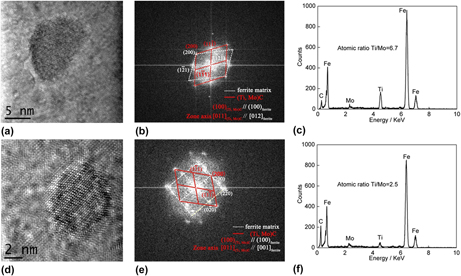Crossref Citations
This article has been cited by the following publications. This list is generated based on data provided by
Crossref.
Larzabal, Gorka
Isasti, Nerea
Rodriguez-Ibabe, Jose
and
Uranga, Pello
2017.
Evaluating Strengthening and Impact Toughness Mechanisms for Ferritic and Bainitic Microstructures in Nb, Nb-Mo and Ti-Mo Microalloyed Steels.
Metals,
Vol. 7,
Issue. 2,
p.
65.
Zaitsev, A. I.
Koldaev, A. V.
Arutyunyan, N. A.
and
Dunaev, S. F.
2018.
Principles of Creating New Economically Alloyed Ferritic Steels with a Unique Set of Properties.
Metallurgist,
Vol. 62,
Issue. 5-6,
p.
532.
Wang, Zhenqiang
Sun, Yuhang
Zhou, Yanyuan
Yang, Zhigang
and
Jiang, Fengchun
2018.
Microstructure, precipitation and mechanical properties of a titanium-tungsten alloyed hot rolled high strength steel.
Materials Science and Engineering: A,
Vol. 718,
Issue. ,
p.
56.
Zhang, Ke
Wang, Hui
Sun, Xin-Jun
Sui, Feng-Li
Li, Zhao-Dong
Pu, En-Xiang
Zhu, Zheng-Hai
Huang, Zhen-Yi
Pan, Hong-Bo
and
Yong, Qi-Long
2018.
Precipitation Behavior and Microstructural Evolution of Ferritic Ti–V–Mo Complex Microalloyed Steel.
Acta Metallurgica Sinica (English Letters),
Vol. 31,
Issue. 9,
p.
997.
Zhao, Jingwei
and
Jiang, Zhengyi
2018.
Thermomechanical processing of advanced high strength steels.
Progress in Materials Science,
Vol. 94,
Issue. ,
p.
174.
Rahnama, Alireza
Clark, Sam
and
Sridhar, Seetharaman
2018.
Machine learning for predicting occurrence of interphase precipitation in HSLA steels.
Computational Materials Science,
Vol. 154,
Issue. ,
p.
169.
Dhara, S.
Marceau, R.K.W.
Wood, K.
Dorin, T.
Timokhina, I.B.
and
Hodgson, P.D.
2018.
Precipitation and clustering in a Ti-Mo steel investigated using atom probe tomography and small-angle neutron scattering.
Materials Science and Engineering: A,
Vol. 718,
Issue. ,
p.
74.
Liu, Yan
Zhang, Luxin
Ye, Haiqing
and
Yao, Yu
2018.
The action mechanism and application of alloying elements in the pressure vessel steel.
IOP Conference Series: Materials Science and Engineering,
Vol. 382,
Issue. ,
p.
022046.
Wang, Zhenqiang
Wang, Jiandong
Dong, Haokai
Zhou, Yanyuan
and
Jiang, Fengchun
2020.
Hardening Through an Ultrafine Carbide Precipitation in Austenite of a Low-Carbon Steel Containing Titanium and Tungsten.
Metallurgical and Materials Transactions A,
Vol. 51,
Issue. 8,
p.
3778.
Wei, He
Chen, Yin-li
Yu, Wei
Su, Lan
Wang, Xuan
and
Tang, Di
2020.
Study on corrosion resistance of high-strength medium-carbon spring steel and its hydrogen-induced delayed fracture.
Construction and Building Materials,
Vol. 239,
Issue. ,
p.
117815.
Zaitsev, A I
Koldaev, A V
and
Arutyunyan, N A
2020.
Influence of the Thermal Deformation Treatment on the Structural State and Properties of Ti-Mo Microalloyed Steels of the Ferritic Class.
IOP Conference Series: Materials Science and Engineering,
Vol. 969,
Issue. 1,
p.
012017.
Zaitsev, Alexander
and
Arutyunyan, Nataliya
2021.
Low-Carbon Ti-Mo Microalloyed Hot Rolled Steels: Special Features of the Formation of the Structural State and Mechanical Properties.
Metals,
Vol. 11,
Issue. 10,
p.
1584.
Modak, Pranabananda
Mandal, Arka
Gupta, Richa
Karmakar, Anish
Sarkar, Sudip Kumar
Ahlawat, Sarita
Haldar, Arunansu
Mitra, Rahul
Neogy, Suman
Biswas, Aniruddha
and
Chakrabarti, Debalay
2021.
Phenomenal Effect of Stable (Ti, Mo)C Nano-Sized Precipitates in Retarding the Recrystallization and Grain Growth in High-Strength Ferritic Steel.
SSRN Electronic Journal ,
Wang, Zhenqiang
Huo, Dongshen
Zhou, Yanyuan
Sui, Guoying
and
Jiang, Fengchun
2022.
Effect of Tungsten Addition on Continuous Cooling Transformation and Precipitation Behavior of a High Titanium Microalloyed Steel.
Metals,
Vol. 12,
Issue. 10,
p.
1649.
Zhu, Wenting
Cui, Junjun
Feng, Yang
Zhao, Yang
Chen, Zhenye
and
Chen, Liqing
2022.
Post‐fire Mechanical Behaviors and the Mechanism of their Influence on a 690 MPa Grade High‐Strength Steel for High‐Rise Buildings.
steel research international,
Vol. 93,
Issue. 11,
Rodionova, Irina
Arutyunyan, Nataliya
Amezhnov, Andrey
D’yakonov, Dmitrii
Gladchenkova, Yuliya
Dunaev, Sergey
and
Vasechkina, Irina
2022.
Effect of Nanosized Precipitates on Corrosion Resistance of Nb-Microalloyed Steels.
Metals,
Vol. 12,
Issue. 4,
p.
636.
Modak, Pranabananda
Mandal, Arka
Gupta, Richa
Karmakar, Anish
Sarkar, Sudip Kumar
Ahlawat, Sarita
Haldar, Arunansu
Mitra, Rahul
Neogy, Suman
Biswas, Aniruddha
and
Chakrabarti, Debalay
2022.
Phenomenal Effect of Stable (Ti, Mo)C Nano-Sized Precipitates in Retarding the Recrystallization and Grain Growth in High-Strength Ferritic Steel.
Metallurgical and Materials Transactions A,
Vol. 53,
Issue. 2,
p.
689.
Kim, Sung Jin
Park, Jin Sung
and
Jung, Seung-Pill
2022.
Corrosion-induced hydrogen evolution, absorption, and cracking behaviors of ultra-high-strength galvanized and galvannealed steel sheets.
npj Materials Degradation,
Vol. 6,
Issue. 1,
Li, Zhaodong
Zhang, Ke
Wang, Wentao
Wang, Xin
Cao, Yanguang
and
Yong, Qilong
2022.
Mechanical Properties and Precipitation Behaviors of a Low‐Mo Nb–V–Ti Complex Microalloyed Fire‐Resistant Steel with Two Kinds of Microstructure.
steel research international,
Vol. 93,
Issue. 5,
Zhu, Wenting
Cui, Junjun
Feng, Yang
Chen, Zhenye
Zhao, Yang
and
Chen, Liqing
2022.
Achieving Excellent Strength‐Ductility Balance and Lower Yield Ratio in a 690 MPa‐Grade Multiphase Construction Steel.
steel research international,
Vol. 93,
Issue. 7,



